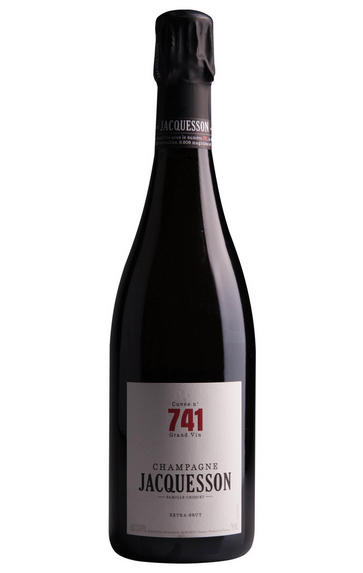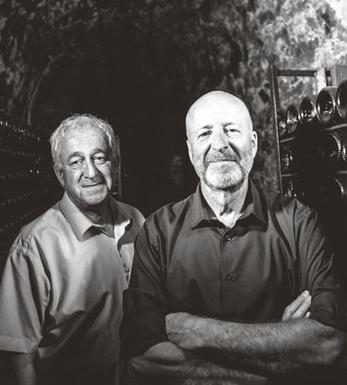
Champagne Jacquesson, Cuvée 741, Extra Brut

Critics reviews
Disgorged in June 2018 with 2.5 grams per liter dosage, the NV Extra Brut Cuvée No. 741 is based on the 2013 vintage. Unfurling in the glass with aromas of white flowers, fresh nectarine and peach, complemented by hints of warm biscuits and walnut oil, it's medium to full-bodied, vinous and concentrated, with a textural attack that gives way to a lively, focused core that's underpinned by a bright spine of acidity, concluding with a long and sapid finish. This superb wine from Jacquesson is complex, expressive, and beautifully balanced.
Drink 2019 - 2033
William Kelley, Wine Advocate (August 2019)
Base harvest 2013 from Aÿ, Dizy, Hautvillers, Avize and Oiry, plus some reserve wines. Vinification and élevage on lees in oak foudres with no filtration or fining. Dosage 2.5 g/l. Released 2018.
Classy concentration immediately, apparently on the nose. It has a lovely, lacy texture but with density underneath. This is very smart stuff. It's just a pleasure to drink now with great balance. Maybe not amazing persistence, but I challenge anyone not to enjoy this.
Jancis Robinson MW, JancisRobinson.com (June 2018)
The signature complexity and aromas of nutty red fruit and preserved yellow citrus make for a very complex and interesting NV style. The palate has a deeply flavoursome core of grapefruit and hazelnuts with a fullish texture and super fresh finish.
Drink now
James Suckling, JamesSuckling.com (September 2018)
About this WINE

Jacquesson
Voted the third best of all Champagne Houses (after Bollinger and Krug) in 2005 La Revue Des Vins De France, Jacquesson has really come of age.
Based in the evocatively named town of Dizy, just to the north of Epernay, the House is run by the Chiquet brothers (cousins of our own Gaston Chiquet). The brothers are long-term advocates of the modish philosophy of zero dosage: this is put to the test in extremis with the equally modish move to release late disgorged cuvées: the juxtaposition of minimal sugar and extended lees ageing has produced these, some of the purest and most poised of all Champagnes, showing at their very best in magnum of course!
The house philosophy of releasing a clearly categorised Brut NV persists therefore, somewhat at odds with the historical precedent in the region which deliberately declines specifically to equate a batch with a certain vintage. Jacquesson's policy of so doing, albeit tangentially, is both a reflection of their adherence to the values of terroir and vintage diversity and a self-belief which over-rides any of the specific anxieties felt by the Champenois in relation to the conditions at a specific harvest.
These are very serious Champagnes with an emphasis on minerality and complexity of fruit. The wines have significant gravitas, are good food companions and age beautifully.

Brut Champagne
Brut denotes a dry style of Champagne (less than 15 grams per litre). Most Champagne is non-vintage, produced from a blend from different years. The non-vintage blend is always based predominately on wines made from the current harvest, enriched with aged wines (their proportion and age varies by brand) from earlier harvests, which impart an additional level of complexity to the end wine. Champagnes from a single vintage are labelled with the year reference and with the description Millésimé.
Non-vintage Champagnes can improve with short-term ageing (typically two to three years), while vintages can develop over much longer periods (five to 30 years). The most exquisite and often top-priced expression of a house’s style is referred to as Prestige Cuvée. Famous examples include Louis Roederer's Cristal, Moët & Chandon's Dom Pérignon, and Pol Roger's Cuvée Sir Winston Churchill.
Recommended Producers : Krug, Billecart Salmon, Pol Roger, Bollinger, Salon, Gosset, Pierre Péters, Ruinart

Champagne blend
Which grapes are included in the blend, and their proportion, is one of the key factors determining the style of most Champagnes. Three grapes are used - Pinot Noir, Chardonnay and Pinot Meunier.
26% of vineyards in Champagne are planted with Chardonnay and it performs best on the Côtes des Blancs and on the chalk slopes south of Epernay. It is relatively simple to grow, although it buds early and thus is susceptible to spring frosts. It produces lighter, fresher wines than those from Burgundy and gives finesse, fruit and elegance to the final blend. It is the sole grape in Blancs de Blancs, which are some of the richest long-lived Champagnes produced.
Pinot Noir accounts for nearly 40% of the plantings in Champagne and lies at the heart of most blends - it gives Champagne its body, structure, strength and grip. It is planted across Champagne and particularly so in the southern Aube district.
The final component is Pinot Meunier and this constitutes nearly 35% of the plantings. Its durability and resistance to spring frosts make the Marne Valley, a notorious frost pocket, its natural home. It ripens well in poor years and produces a soft, fruity style of wine that is ideal for blending with the more assertive flavours of Pinot Noir. Producers allege that Pinot Meunier lacks ageing potential, but this does not deter Krug from including around 15% of it in their final blends.


Buying options
Add to wishlist
Description
Disgorged in June 2018 with 2.5 grams per liter dosage, the NV Extra Brut Cuvée No. 741 is based on the 2013 vintage. Unfurling in the glass with aromas of white flowers, fresh nectarine and peach, complemented by hints of warm biscuits and walnut oil, it's medium to full-bodied, vinous and concentrated, with a textural attack that gives way to a lively, focused core that's underpinned by a bright spine of acidity, concluding with a long and sapid finish. This superb wine from Jacquesson is complex, expressive, and beautifully balanced.
Drink 2019 - 2033
William Kelley, Wine Advocate (August 2019)
wine at a glance
Delivery and quality guarantee